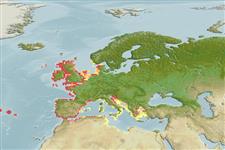Common names from other countries
>
Gobiesociformes (Clingfishes) >
Gobiesocidae (Clingfishes and singleslits) > Lepadogastrinae
Etymology: Apletodon: Greek, aplatos, apletos = terrible + Greek, odous = teeth (Ref. 45335).
Environment: milieu / climate zone / depth range / distribution range
Écologie
marin démersal. Temperate; 60°N - 30°N
Eastern Atlantic: Scotland in UK to western Mediterranean.
Taille / Poids / Âge
Maturity: Lm ? range ? - ? cm
Max length : 4.0 cm SL mâle / non sexé; (Ref. 4765)
Found in littoral and sublittoral zones.
Life cycle and mating behavior
Maturité | Reproduction | Frai | Œufs | Fécondité | Larves
Briggs, J.C., 1986. Gobiesocidae. p. 1351-1359. In P.J.P. Whitehead, M.-L. Bauchot, J.-C. Hureau, J. Nielsen and E. Tortonese (eds.) Fishes of the North-eastern Atlantic and the Mediterranean, volume 3. UNESCO, Paris. (Ref. 4765)
Statut dans la liste rouge de l'IUCN (Ref. 130435)
CITES (Ref. 128078)
Not Evaluated
Menace pour l'homme
Harmless
Utilisations par l'homme
Plus d'informations
Taille/ÂgeCroissanceLongueur-poidsLongueur-longueurFréquences de longueursMorphométrieMorphologieLarvesDynamique des populations larvairesRecrutementAbondance
RéférencesAquacultureProfil d'aquacultureSouchesGénétiqueElectrophoresesHéritabilitéPathologiesTraitementMass conversion
CollaborateursImagesStamps, Coins Misc.SonsCiguateraVitesseType de nageSurface branchialeOtolithesCerveauxVision
Outils
Articles particuliers
Télécharger en XML
Sources Internet
Estimates based on models
Preferred temperature (Ref.
115969): 9.9 - 19.4, mean 14 (based on 453 cells).
Phylogenetic diversity index (Ref.
82804): PD
50 = 0.5156 [Uniqueness, from 0.5 = low to 2.0 = high].
Bayesian length-weight: a=0.00513 (0.00202 - 0.01305), b=3.11 (2.89 - 3.33), in cm Total Length, based on LWR estimates for this (Sub)family-body shape (Ref.
93245).
Niveau trophique (Ref.
69278): 3.1 ±0.5 se; based on diet studies.
Résilience (Ref.
120179): Haut, temps minimum de doublement de population inférieur à 15 mois (Preliminary K or Fecundity.).
Fishing Vulnerability (Ref.
59153): Low vulnerability (10 of 100).
